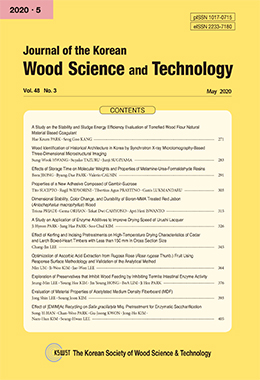옻칠의 건조속도를 향상시키기 위해 Laccase를 적용하여 효소첨가제로써의 가능성을 확인하고자 하였다. 옻칠의 Laccase와 부후균의 Laccase를 적용한 경우 국내산과 중국산 모두 건조시간이 단축되었다. Laccase를 적용한 시험편 모두 건조시작 60분 안에 지촉건조가 이루어졌으며, Laccase의 함량비율이 높아질수록 건조속도가 향상되었다. 또한 국내산 옻칠과 중국산 옻칠의 경화건조시간의 차이는 있지만 온도 20 ± 2 °C, 습도 55-60 %의 상온에서도 경화건조가 이루어지는 것이 확인되었다. 건조된 시험편의 도막분석 결과, 우루시올 대비 Laccase 함량비율이 5:1일 때 건조속도가 향상되었으며, 색차와 밀착력의 차이가 없고 도막이 안정적임을 확인하였다. Laccase를 적용한 경우 국내산과 중국산 옻칠의 광택도가 모두 감소되는 양상이 관찰되었으나 이외 FT-IR과 Py-GC/MS의 분석결과 물성에 영향을 미치는 정도의 성분변화는 나타나지 않아 첨가제로써의 적용 가능성을 확인하였다.
Laccase was applied to improve the drying speed of urushi lacquer to confirm a potential use of laccase as an enzyme additive. As a result of applying laccase of lacquer and white-rot fungi, drying times for both Korean and Chinese specimens were reduced. All of the specimens to which laccase was applied were dried(set to touch) within 60 minutes from the start of the drying, and the drying rate was improved as the content ratio of laccase increased. In addition, although there were differences in hardening drying time between Korean and Chinese lacquers, it was confirmed that hardening drying took place even at room with temperature of 20 ± 2 °C and humidity of 55-60%. As a result of lacquer layer analysis of the dried specimens, the drying speed was improved when the content ratio of laccase to urushiol was 5:1, and there were no differences in chromaticity and adhesion, confirmed that the layers were stable. It was observed that the gloss of both Korean and Chinese lacquers were reduced when laccase was applied. However, according to the analysis of FT-IR and Py-GC/MS, the changes in components were not as sufficient to affect the physical properties. Thus, its applicability as an additive was confirmed.




